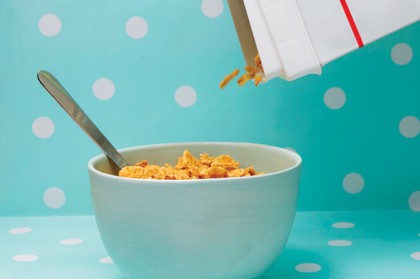
Walk down the cereal aisle of your supermarket and you might notice something a bit different. There’s now a smattering of stars in the corner of many food packages that look similar to the energy ratings on appliances. Some Weet-Bix and Uncle Tobys Oats products are twinkling away with five stars, there’s a muesli with four and bran flakes have three-and-a-half.
Welcome to Health Star Rating, the new system that packaged food brands are now using to show how healthy their products are. The system made headlines when it was announced mid last year, but it’s only become really visible in our supermarkets in the past few weeks.
Coles has more than 100 star-rated home-brand products. Eleven other brands have released starred products, including Uncle Tobys and Sanitarium, and Woolworths is poised to join them. Breakfast cerealswere the first to embrace the system, but stars are also on muesli bars, packaged salads and peanut butter.
The system has been more than two years in the making, and in that time has been the subject of intense debate among dietitians, food manufacturers and the government. And it still has fierce critics. After all, this is a program that would rank both an apple and the processed breakfast drink Up&Go with five stars. So how useful is it for regular consumers?
How it works
The Health Star Rating (HSR) system was created by the Federal Government to rank food products on a scale of half a star to five stars. “Just like with the energy ratings on appliances, the more stars, the better the product,” nutritionist and food commentator Catherine Saxelby explains.
The amount of stars is determined by a formula that takes into account the type of food, its calories, its “negative” nutrients (saturated fats,sugars and sodium) and the “positive” nutrients (protein, fibre and concentration of fruits/vegetables/legumes/nuts) per 100g or 100ml.
“The formula is best designed to compare foods in the same category,” Saxelby says. “So you can compare two breakfast cereals, but it’s not useful to compare the stars on a tub of yoghurt with a pack of nuts.”
This system was created for packaged food, not fresh fruit and vegetables (which would score five stars anyway). You also won’t see it on alcohol, tea, coffee or items that wouldn’t be consumed on their own, such as flour or vinegar.
The HSR system is currently voluntary, so manufacturers can decide whether they adopt it or continue to use the also voluntary Daily Intake Guide (%DI) graphic on packaging. They have until next January to choose, as the system will be reviewed in mid-2016.
Why it’s effective
There’s no denying the star system is a much easier way to get at-a-glance nutritional information than the existing %DI graphic.
“It’s bringing nutrition to the front of people’s minds and that’s a big positive,” accredited practising dietitian Kara Landau says, adding that the %DI system has been criticised as being confusing. “When clients have asked about the ‘percentage of daily intake’ figures, it’s always with confusion – what do the numbers really mean? Those figures are based on the needs of the ‘average Australian’ and I don’t believe most people fit that criteria.”
The star system will also help cut through the misleading terms and claims that many food manufacturers are known to employ. Saxelby says that a dairy product now needs to have a rating of four stars or higher to say that it’s a high source of calcium.
On the whole, the system works by distinguishing between junk food and healthy choices. Saxelby has calculated the stars for dozens of popular foods on her blog foodwatch.com.au, and says that junk food (such as chocolate bars and fizzy drinks) or unhealthy foods generally get less than one star, while whole, healthy foods get five stars.
With the spotlight increasingly turning to the high sugar content of “healthy” foods such as low-fat yoghurt, sports drinks and muesli bars, the star system will help promote products that don’t have any or much added sugar, Landau says. It will also remind people that nutrient-dense foods, such as nuts, are healthy, even if they do contain some fat.
“People are still nervous about nuts, but the stars would show us how good they are,” she says. “Under the HSR system, roasted unsalted pistachios would rate five out of five, and even lightly salted would rate four-and-a-half stars due to their nutritional qualities.”
Where it stumbles
While nuts might get a great ranking from the HSR, other nutrient-rich foods don’t fare so well. Take extra-virgin olive oil – Saxelby says this has been shown in hundreds of studies to improve our health and it’s overflowing with antioxidants, however, it only gets a three-and-a-half star rating – the same as a refined margarine spread and less than the four-star ranked refined canola oil – and all because it has slightly more saturated fat.
Rob McGavin, head of Cobram Estate, which produces 65 per cent of Australia’s olive oils, has loudly protested the way oils are rated. “By ignoring the presence of antioxidants and the absence of trans-fats, star ratings generated by the HSR system will mislead consumers,” he says.
Landau also uses the example of water crackers: “They’re high in refined carbs, but they can still score quite high at four or four-and-a-half stars,” she says. “They have no negative nutrients according to this system, but they don’t have any positive ones either. My concern is that people may use the stars to justify eating these empty calories over core foods like fruit, vegetables, nuts and seafood.” Saxelby adds that the ratings also don’t help if you want to buy organic or local foods.
Another interesting example of how the HSR system can rewardprocessed foods came about recently when Sanitarium announced that its new Up&Go Reduced Sugar breakfast drink will rate five out of five stars.
However, Saxelby doesn’t see this as a problem. “I think it’s great that the star rating encourages companies to reformulate, just as The Tick did to get lower salt, smaller portioned products,” she says. “I believe the HSR is meant to go on processed foods so shoppers can see quickly if it’s good or not.”
Finally, there’s the fact that the HSR is voluntary. “I can’t imagine why anyone whose food would score less than two stars would voluntarily put that on the front of their packaging,” Saxelby says. “I don’t ever see it going on soft drinks or cheap generic snack foods. Most of the products that will take the stars up will be four stars and above.”
Make the stars work for you
Landau’s tips for navigating the new system:
- Compare similar foods: “Only use the stars to compare foods within the same category, so compare yoghurt with yoghurt. Look for the option that has the most stars.”
- Use common sense: “Remember the stars measure key components, but they also don’t take into account additional factors like antioxidants, vitamins and minerals (except salt). The Mediterranean way of eating is a great balanced approach, which encourages food choices heavy on fruits, vegetables, olive oil, nuts, fish and beans with limited dairy, red meat and red wine.”
- Keep portion control in mind: “The Health Star Ratings offer front-of-pack data to make it simple to compare foods at the 100g or millilitre level, but remember you’re not always likely to eat that much (such as with nuts) or that little (a smoothie serving can be between two and six times that much).”
Source: bodyandSoul
 We are sharing information for knowledge. Presented by. SocialDiary.Net
We are sharing information for knowledge. Presented by. SocialDiary.Net



